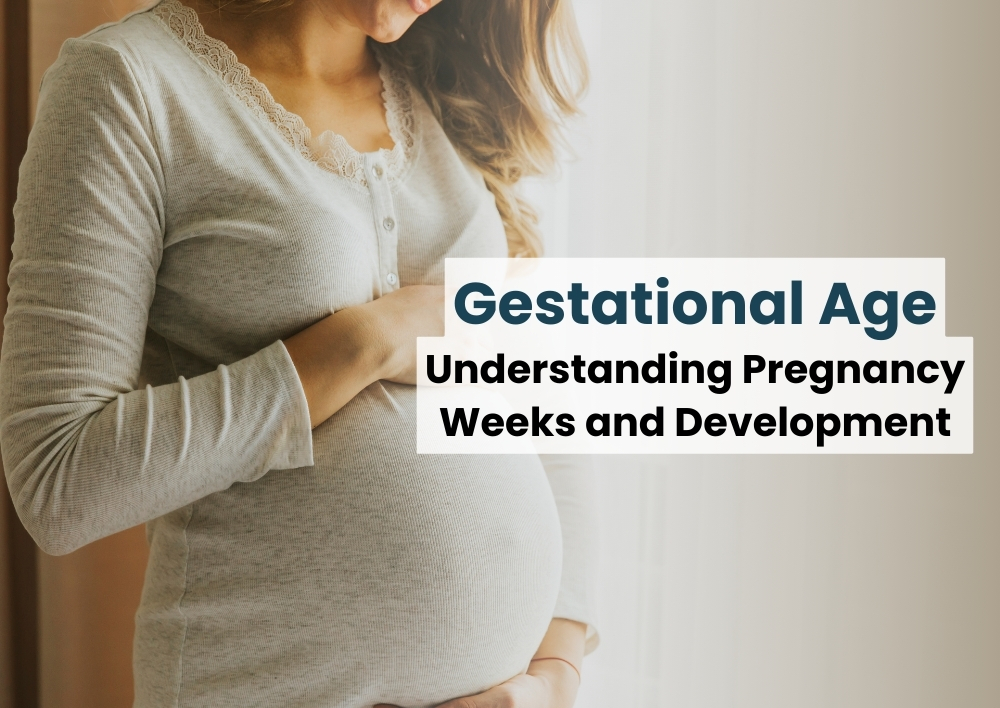Gestational Age: Understanding Pregnancy Weeks and Development
Summary: Gestational age is a crucial measure of pregnancy, calculated from the first day of the last menstrual period (LMP). It helps track fetal development, estimate the due date, and schedule important prenatal tests. Understanding gestational age ensures proper monitoring of both the baby's and mother's health throughout the pregnancy.
Did you know that your pregnancy is counted even before conception happens? That is right! The pregnancy journey is measured in weeks, starting from the first day of your last menstrual period (LMP), even though actual fertilization occurs about two weeks later. This is because it is usually difficult to determine the exact date of conception, so doctors use the LMP as a standard reference point. This method helps a gynaecologist track your baby’s development, estimate the due date, schedule important prenatal tests, and monitor overall pregnancy health.
Understanding gestational age is important for doctors and expecting parents to ensure a smooth and well-planned pregnancy journey. In this blog post, the best gynaecologist in Gurgaon at Miracles Apollo Cradle provides insight into the importance of understanding gestational age during your pregnancy. Whether you are a first-time mom or have been through the journey before, understanding how far along you are and why it matters can help make your pregnancy journey smoother and more informed.
What is Gestational Age in Pregnancy?
Gestational age means the number of weeks a pregnancy has lasted, calculated from the first day of a woman's last menstrual period (LMP). This measurement is divided into three trimesters, each representing different stages of fetal development. The first trimester (weeks 1-12) marks the early stages of organ formation and rapid growth. The second trimester (weeks 13-26) sees significant development in the baby’s body, including the growth of bones, muscles, and organs. Finally, the third trimester (weeks 27-40) is when the baby’s growth accelerates, and the body prepares for birth. A full-term pregnancy typically lasts about 40 weeks, but it is important to note that pregnancies should be 40 weeks.
Gestational age is used as a standard because pinpointing the exact date of conception is often difficult. The timing of ovulation and fertilization can vary from woman to woman, and factors like cycle length can impact when conception occurs. Therefore, using the first day of the LMP is a more reliable method to estimate a pregnancy’s progress.
How to Calculate Gestational Age Manually?
To calculate gestational age manually, you need to use the first day of your last menstrual period (LMP) as a reference point. Here is how you can do it:
-
Identify the first day of your last menstrual period (LMP): The LMP is the starting point of the calculation. This is the first day of your most recent menstrual cycle before you became pregnant.
-
Count the weeks from your LMP: Start from the first day of your last menstrual period and count the number of weeks that have passed. Pregnancy typically lasts around 40 weeks (or 280 days) from the first day of the LMP, but this can vary.
-
Use a simple method to calculate: If the first day of your LMP was January 1st, and today’s date is February 10th, you can count the number of weeks between these two dates. This would indicate how many weeks along you are in your pregnancy.
-
Alternatively, use a gestational age calculator: To make the process easier and more accurate, you can use an online gestational age calculator. These tools allow you to enter your LMP and provide an estimated gestational age, along with the expected due date.
It is important to note that this manual calculation assumes you have a regular menstrual cycle, typically around 28 days. If your cycle is shorter or longer, the gestational age may need to be adjusted accordingly. For a more accurate assessment, your gynecology doctors also use ultrasound measurements, which can help to fine-tune the gestational age calculation. However, the LMP method remains the standard approach for determining the gestational age early in pregnancy.
Other Methods to Calculate Gestational Age
In addition to calculating gestational age based on the first day of your last menstrual period (LMP), there are a few other methods used to estimate gestational age. Each method has its advantages and is chosen based on the available information or the stage of the pregnancy.
1. Ultrasound Measurements: Ultrasound is one of the most accurate ways to calculate gestational age, especially in the early stages of pregnancy. During an ultrasound, a technician can measure the size of the developing fetus, which can help estimate its gestational age. Common measurements include:
-
Crown-rump length (CRL): The length of the baby from the top of the head to the bottom of the torso. This measurement is most accurate in the first trimester.
-
Biparietal diameter (BPD): The width of the baby’s head, used in the second and third trimesters.
-
Femur length (FL): The length of the baby’s thigh bone, which can be used along with other measurements to determine gestational age.
Early ultrasounds tend to be more accurate for calculating gestational age than those done later in pregnancy, as babies grow at a more uniform rate early on.
2. Ballard Maturation Scale: The Ballard Maturation Scale is a scoring system used to assess the maturity of a newborn baby. It is based on physical and neurological criteria, including the baby's posture, skin texture, and muscle tone. By assessing the baby's development shortly after birth, gynaecologist can estimate the gestational age. This method is most commonly used for babies born prematurely.
3. Naegele's Rule: Naegele’s Rule is a standard formula used to estimate a woman's due date, which is based on her LMP. Once the first day of the last period is known, you can apply this formula:
-
Begin from the very first day of your last period.
-
Add one year.
-
Subtract three months.
-
Add seven days.
This gives an estimate of the due date, and you can subtract 2 weeks from the total to estimate the gestational age at a given point.
4. Maternal Symptoms and Signs: In some cases, a healthcare provider may use the maternal symptoms and signs in early pregnancy to estimate gestational age. These can include things like:
-
Morning sickness: The timing and intensity of nausea can sometimes indicate how far along a pregnancy is.
-
Breast changes: Enlargement or tenderness of the breasts, especially in early pregnancy, can also provide clues.
However, this method is very imprecise and should only be used as a supplementary approach.
5. Ovulation and Conception Dates: If you are tracking ovulation or know the exact date of conception (such as from fertility treatments), you can estimate gestational age starting from the date of conception. Since conception typically occurs about 14 days after the first day of the LMP in a regular 28-day cycle, gestational age can be calculated from that point.
Why is Gestational Age Important?
Understanding gestational age is essential for both the expectant mother and healthcare providers throughout the pregnancy. It serves as a foundation for monitoring both the health of the baby and the mother. Here are some key reasons why knowing gestational age is important:
1. Tracking Baby’s Growth: Knowing the gestational age helps doctors track the baby’s growth and development. As the pregnancy progresses, various milestones need to be met. For instance, in the first trimester, doctors will expect to see the baby’s heartbeat and basic organ development. By monitoring the gestational age, they can ensure that the baby is growing at a healthy rate, and any concerns related to growth restrictions can be addressed early. This also helps detect if the baby is ahead or behind in its growth compared to typical development patterns.
2. Determining the Due Date: The gestational age is a key factor in estimating the due date. Knowing when conception occurred or calculating from the LMP gives a timeline that predicts when the baby will be born. This is essential for preparing for labor and delivery, as it allows the mother and healthcare providers to plan ahead for the birth. Although only about 5% of babies are born on their exact due date, this estimate helps in making preparations for the upcoming birth, including choosing a birth plan and arranging necessary healthcare services.
3. Scheduling Important Tests: Pregnancy involves several key tests and screenings to ensure both the mother’s and baby’s health. The gestational age plays a role in scheduling these tests at the right time.
-
Nuchal Translucency (NT) Scan: This scan is typically done between 11 and 14 weeks to assess the risk of chromosomal conditions, such as Down syndrome.
-
Glucose Tolerance Test: Done between 24 and 28 weeks, this test helps screen for gestational diabetes, a condition that can arise during pregnancy.
-
Anatomy Ultrasound: Performed between 18 and 22 weeks, this ultrasound checks the baby’s organs, growth, and overall development.
By knowing the gestational age, doctors ensure that these tests are performed at the optimal time, enhancing their accuracy and providing better information for the mother’s care.
4. Detecting Complications: Gestational age helps detect potential complications in pregnancy, such as preterm labor, fetal growth restriction, or even conditions like preeclampsia. When a pregnancy is not progressing as expected, knowing the precise gestational age enables healthcare providers to take early action. It helps in detecting complications like:
-
Preterm Birth: If the pregnancy is too early (before 37 weeks), doctors can prepare for premature birth, ensuring the baby receives the appropriate care in a neonatal unit.
-
Growth Delays: If the baby is falling behind in growth or showing signs of fetal distress, appropriate measures like early delivery or closer monitoring can be taken.
5. Monitoring Maternal Health: Gestational age also plays a role in monitoring the mother's health. Conditions such as high blood pressure, gestational diabetes, and preeclampsia can develop at different stages of pregnancy. Knowing the gestational age allows healthcare providers to identify these conditions early and manage them effectively, helping the mother stay healthy throughout the pregnancy.
Conclusion:
Gestational age is the number of weeks a pregnancy has lasted, calculated from the first day of the last menstrual period (LMP). It is an essential metric that allows healthcare providers to track fetal development, estimate the due date, and schedule key prenatal tests at the right time.
If you are unsure about your gestational age, or if you have any concerns regarding your pregnancy, consult the best gynaecologist near you at Miracles Healthcare. An expert can offer personalized advice, monitor your progress, and ensure the best possible outcome for both you and your baby.



_in_Pregnancy.webp)









Was the information useful?
3 0